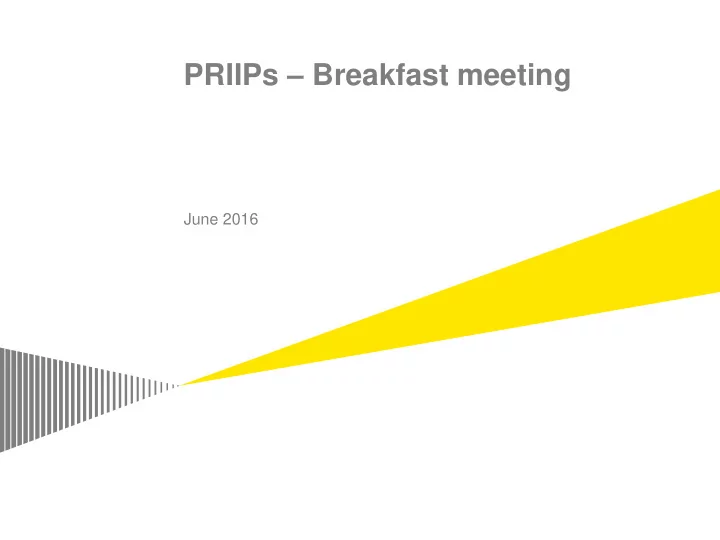

PRIIPs – Breakfast meeting June 2016
Table of Contents ► Challenges ► Risk Indicators ► Performance scenarios ► Costs ► MOPs Page 2
01 Challenges Page 3
KID – a short and easily understandable factsheet covering the key features of the product Key Information Document Content Stand-alone document, separate from marketing • material Focus on information that retail investors need • 3 pages (DIN-A4) • Standardized format and content • Form Accurate, fair, clear and not misleading information • Written in English and/or the official language of • countries of PRIIP distribution On paper, durable medium and on website • To be received by the retail investor in good time Timing • before the conclusion of a transaction To be produced and updated on a periodic basis • Page 4
KID: content and format Leveraging on the UCITS KIID A standardized and pre-contractual document written in a clear language and ► clearly separated from marketing materials. The main format and content of the KID will be as follows: ► Title: “Key Information Document” “What are the costs?” & generic statement ► Disclosure of the costs associated with an investment in the PRIIP in the form of summary indicators and total aggregate “What is this product?” costs expressed in monetary and percentage terms; ► Investment type; ► direct and indirect costs to be borne by the retail investor, including one-off and recurring costs; ► Objectives and means on how to achieve them; ► Costs of distribution of the PRIIP to be provided to the investor ► Whether the product offers insurance benefits (including detail) in addition and terms of the products (if applicable); “ How long should I hold it and can I take money out early? ” “ What are the risks and what could I get in return? ” ► cooling off period or cancellation period for the PRIIP, where ► Summary risk indicator & narrative explanation of the applicable applicable; risks; ► Recommended holding period; ► Possible maximum loss; ► Ability, conditions and consequences for making disinvestments ► Performance scenarios and underlying assumptions; before maturity; “ What happens if the PRIIP manufacturer is unable to pay out? ” “ How can I complain? ” ► Whether the related loss is covered by an investor ► How and to whom an investor can complain; compensation or guarantee scheme; “ Other relevant information ” ► Name of the guarantor and which risks are covered; ► Additional information to be provided to the retail investor at the pre-contractual and/or post-contractual stages ► The KID is a living document and must be up-to-date at all times Page 5
KID - definition of methodologies for risk indicators as key challenge 1 Risk indicator Market Credit Liquidity Future scenario approach relying on quantitative modelling Four approaches that are being considered as viable : Indicator which separates Two-level indicator where market risk and credit risk. the first level roughly Qualitatively based indicator Indicator based on Market risk in this indicator separates products based which combines credit and quantitative market and is assessed by a on their qualitative market risk, complemented credit risk measures and is quantitative volatility characteristics and the by a quantitative market risk calculated by using forward measure and credit risk is second level specifies the measure. looking simulation models assessed by a qualitative risk based on a quantitative external credit rating assessment. Challenges: • The Market Risk Measure (MRM) calculation is dependent on the PRIIPs categorization • Classification of the investment products according to the PRIIPS categorization is unclear • Confidence interval to compute the VaR is not aligned between UCITS and other PRIIPS subject products creating challenges for multi option products (MOPs) • … Page 6
KID – definition of methodologies for performance scenarios as key challenge 2 Performance scenarios Future scenario approach relying on quantitative modelling Four approaches are highlighted for performance scenarios: Let the manufacturer of a PRIIP decide Let the manufacturer of a PRIIP Prescribe which scenarios should be Take probabilities of outcomes into decide which scenarios to present in included in the KID account in the scenario selection which scenarios to present in the KID Prescribe which scenarios should be Take probabilities of outcomes into the KID (the so called what-if: (the so called what-if: manufacturer included in the KID account in the scenario selection manufacturer choice). choice). Combination of the previous approaches Combination of the previous approaches Challenges: • Comparability of future performance scenarios between all types of PRIIPs • Models to compute different scenarios not aligned • Assumptions can largely be different between PRIIPs manufacturers • Computation of interim performance scenarios for liquid products Vs illiquid products • … Page 7
KID – definition of methodologies for identifying costs as key challenge 3 Individual costs Future scenario approach relying on quantitative modelling • Identifies the different types of costs of the different types of PRIIPs (in particular, funds, structured products and life-insurance products), and identify the specific issues related to the calculation of some of these costs • Assesses the different ways of aggregating these different types of costs, including the different possible definitions of the overall cost ratio (summary cost indicator), and the possible ways of calculating the cumulative effect of costs Challenges: • Transactions costs should be calculated on three years historic data. Accuracy can be questioned. • Model based on “arrival price” , unsuitable to calculate transaction costs • Unavailability of data on market prices to establish mid market prices for non equity products. • Comparability between insurance products and asset management products. • … Page 8
Recommend
More recommend